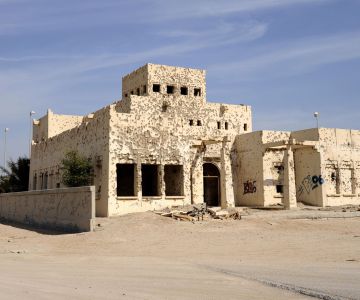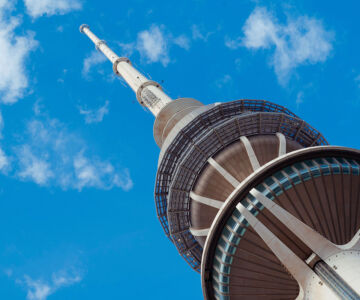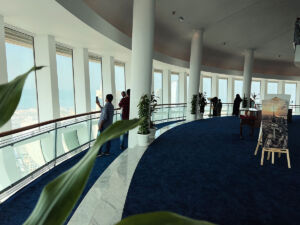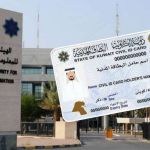Kuwait’s cutting edge history started in the eighteenth century with the establishment of the city of Kuwait associated with the Uteiba segment of the Anaiza clan, who roamed north from Qatar. Kuwaitis are the relatives of a few migrant clans and tribes who at last chose the shore of the Arabian Gulf during the 18th Century to keep away from the determined dry spell of the desert. At the point when they showed up at the coast, the factions assembled fortresses to shield themselves from other traveling clans who actually navigated the desert. The name of “Kuwait” is extracted from “kut”, an Arabic word for “stronghold” or “Fort.”
The first direct contact with the West was somewhere in the year of 1775 and 1779, when the British-controlled Persian Gulf-Aleppo Mail Assistance which was redirected via Kuwait from Persian-held Basra.
During the nineteenth century, Kuwait attempted to get British help to keep up its freedom from the Turks as well as discrete and powerful Peninsulas of Arab.
In the year of 1899, the ruler Sheikh Mubarak Al Sabah “the Great” consented to a contracted term with the United Kingdom promising himself and his descendants neither to surrender any region nor to get operators or agents of any unfamiliar force without the British Government’s authorization. The British consented to allow a yearly endowment to help the Sheikh and his beneficiaries to cope up with scenarios they are facing to manage as well as to give its security. Kuwait appreciated these exceptional contracted terms with the United Kingdom, which took care of Kuwait’s foreign concerns and was answerable for its security.
By mid-1961, the organized elite court system had been removed from the British authorities, which dealt with the foreigner’s cases who are living in Kuwait, which lead the Kuwaiti Government to practice legitimate administration under new laws drawn up by an Egyptian legal scholar. On June 19 in 1961, Kuwait turned out to be completely autonomous after a trade of notes with the United Kingdom.
Boundaries associated with Saudi Arabia was established in the year 1922 with the alliance of Uqair following the Battle of Jahrah. This alliance likewise settled the Neutral zone linked with Kuwait-Saudi Arabia, a territory of around 5,180 sq. km. (2,000 sq. mi.) connecting southern Kuwait’s outskirts. In December 1969, Kuwait and Saudi Arabia consented to contract terms that partitioned the Neutral Zone (presently called the Divided Zone) and differentiating another worldwide limit. The two nations share similarly the Divided Zone’s oil, coastal as well as offshore treasures which directly linked with their economy.
The Northern Border of Kuwait with Iraq is a story that has its impact in the cores of history books. It dates from a contracted term which is made with Turkey in the Year of 1913. Iraq acknowledged the associated contracted terms in the Year of 1932 upon its autonomy from Turkey. In any case, following the freedom of Kuwait’s in the Year of 1961, Iraq presented the Claims on Kuwait, under the affectation that Kuwait had been important for the Empire associated with Ottoman which is subjected to Iraqi supremacy.
In 1963, Iraq avows its acknowledgment of Kuwaiti power which goes to the boundaries as well. It consented to in the Year of 1913 and 1932, in the “Concurred Minutes between the State of Kuwait and the Republic of Iraq associated with the reinstatement of Friendly Relations, Acknowledgements, and Related Matters.”
In August 1990, Iraq in any case attacked Kuwait, violating the contracted terms, however it was constrained out 7 months after a UN alliance drove by the United States.
In November 1994, Iraq officially acknowledged the UN-delineated fringe with Kuwait, which had been additionally illuminated in council Resolution associated with the security 773 and 883. The authorities of Iraq have, in any case, freely demonstrated that they may again endeavor to involve Kuwait forcibly.
The Exiled Territory of Kuwait
About a quarter-century ago, Failaka Island, A Constant souvenir of the Iraqi attack lies in the shadows of ruins, 20km off the shoreline of Kuwait City. Preceding the Gulf War, Failaka was apparently home to around 2,000 inhabitants, however, they evade when the Iraqis attacked and most of them didn’t return.
Throughout the Years, the residential areas, and workplaces they gave up and have disintegrated, many actually blemish with the bullet holes linked from the war.
Today, a great part of the island lies unfilled and in ruins of the war, albeit a little the travel industry has developed – with boat trips, short-term facilities, and bistros jumping up on Failaka for inquisitive tourists. Failaka is likewise still utilized today for military activities by the Kuwaiti armed force.
The Royal Bloodline Descendants of Kuwait
Sheikh Jabir the second, son of Sheikh Mubarak Al-Sabah acted as ruler followed by him from the year of 1915-17, following other successors to the realm, Sheikh Salim Al-Mubarak Al-Sabah, Son of Sheikh Mubarak Al-Sabah from the year of 1917-21. Resulting Emirs are basically descended from these two siblings. From the year 1921 to 1950, Sheikh Ahmed al-Jabir Al Sabah has control over Kuwait. From Year 1950 to 1965, Sheikh Abdullah al-Salim Al Sabah ruled over Kuwait. He is considered as the first Emir of Kuwait. From the year of 1965–1977 Sheikh Sabah Al-Salim Al-Sabah ruled over Kuwait, as Second Emir of Kuwait. The Third Emir of Kuwait Sheikh Jaber Al-Ahmad Al-Sabah had his era from the year of 1977 to 2006. The beloved Emperor ruled over Kuwait since its freedom from Britain. In the past, he withheld the post of Finance minister as well as minister of the economy from the year of 1962 to 1965. Sheikh Jaber was allotted as the Prime Minister former becoming the ruler of Kuwait. He was the most important figure in making Kuwait a dominant and powerful figure that can be easily recognized today. He was loved by both, Expats and Nationals.
The Fourth acted Emir of Kuwait was Sheikh Saad Al-Abdullah Al-Salim Al-Sabah from 15th to 29th January in the Year of 2006. Sheikh Saad withheld the post of General Commander within the Kuwait Military. The Fifth Emir Sheikh Sabah Al-Ahmad Al-Jaber Al-Sabah from the Year of 2006 to 2020. From January 29th, 2006, he also acted as Commander of Kuwait Military Forces until his demise in the Year of 2020.
The current Emir of Kuwait is Sheikh who was born in Kuwait on June 25, 1937. The current Emir is the son of Ahmad al-Jaber al-Sabah, the tenth leader of Kuwait. Sheikh Nawaf is the third of his siblings to manage Kuwait as a component of the dynasty of Kuwait that has governed the nation since the year of 1756.
In the year of 2006, Sheikh Nawaf was authoritatively assigned as the Crown Prince. All through his long term vocation, he held numerous situations inside the Kuwaiti government. In 2003, he was named the primary Deputy Prime Minister of Kuwait and Minister of Interior. At the point when the late Emir was in the United States getting clinical treatment, Nawaf took care of a considerable lot of his duties. Presently, he is the sixteenth leader of the House of Sabah and the 6th Emir of Kuwait. Kuwait has a chosen parliament, however, the Emir is the head with control over the undertakings of state.
The Freedom Reign
On the day of June 19th 1961, Kuwait got autonomous with the termination of the British possession. Sheikh Abdullah Al-Salim Al-Sabah turned into an Emir. Most nations commend their public day on a similar date they procure their freedom. After two years, to maintain a strategic distance from the outrageous June heat, the legislature of Kuwait moved National Day to February 25th.
The whole nation celebrations incorporate a noteworthy firecracker parade as well as public social events with food, drinks, and loads of diversions linked with all sorts of activities. Family social gatherings are frequent on National Day with public regions, for example, the beach of Messila and the leisure park of Al-Sha’ab are the mainstream spots to meet and have a quality time.
The Residents of Kuwaiti praise their freedom in a manner that don’t show energy or give an indication of unwaveringness to their nation. The celebration was more hazardous than fun and it formed into rougher event later on. The party foam was splashed generously on the crowd celebrating the Independence Day without a worry to their wellbeing or security. The nature of the water that was utilized in the water guns could be polluted or supplanted with other destructive fluids. There were used to be a lot of Blended vehicles, groups, and drivers on the road which leads to the turbulence of traffic and blockage of roads which were eventually turned into terrible mishaps. Many reports suggested that the rate of accidents increased on Independence Day with causalities reported from Hospitals due to fights and car accidents.
Written in the Stars
Kuwait marked its name in the books of Guinness World record with a huge showcase of firecrackers. The mega show cost a total of KD 4.16 million or $15 million US. The display was sensuous and tremendous with 77,282 firecrackers launched utilizing sparklers over a time of one hour to make sure about the greatest and most expensive firecracker accomplishment ever. A great number of individuals accumulated around Gulf Street to get the signified and marvelous view at firecrackers. Other than that the whole event includes a kite and laser show to stamp the 50th anniversary of their legislation.
Toward the finish of the event, there were 3D projections which were shown on the Guinness World record flag for the greatest number of firecrackers with that for the longest queue. The Tower of Kuwait to the boundaries of Green Island is isolated into Nine Zones as a delegate from Guinness World Record which was declared over the public television of Kuwait.
Substitution of Currency
The money as banknotes and coins has been there in Kuwait for over 200 years. The Dinar of Kuwait marked its place in the market in the year of 1960. It supplanted the Gulf Rupee which was beforehand being used. Those notes comprised of brilliant tones with shades of red, green, and blue. In the Past, designs comprised with the representations of 2 main Rulers on Kuwaiti banknotes, Sheikh Sabah bin Salim al-Sabah and Sheikh Abdullah Al-Salim.
The modification in the Kuwaiti Dinar took place in the Holy Month of Ramadan in the Year of 2019, assigned by the Central Bank of Kuwait. The breathtaking monuments of Kuwait can be seen on the new banknotes, establishing the view of the Kuwaiti flag which tends to represent the national identity of the country. Each one of them has its historical and devised meaning showcasing the marine environments, Kuwaiti deserts as well as the island of Failaka. The Notes also include the main monuments like the tower of liberation, the pearl diving, the tower of Kuwait, the Grand Mosque, and more. Few of the notes are coarsely designed taking into consideration the people who are blind. The running currency is still in circulation and will be till further order is released to cast it out.
The Ethnic Kuwaiti Significance
The Kuwaiti coat of arms (though about a token) was received in the Year of 1962 and is made out of a brilliant Falcon bearing a shield portraying the public banner. Inside the wings of the falcon (an image of the tribe of Banu Quraish) is a boat cruising over water with Kuwait’s complete name composed above in the language of Arab. The banner of Kuwait was formally received on September 7, 1961.
The customary shades of Pan-Arab linked with dark, green, red and white are utilized on the banner. Dark represents annihilation of the nation’s adversaries; green represents the richness; red is emblematic of massacre, and white speaks to purity.
No country is complete without Good Food in it. Kuwaiti food is a modified mixture and tradition of Arabs, Persia, and Mediterranean cooking styles. An unmistakable dish in the royal cuisine of Kuwait is “Machboos”, a dish based on rice extravagantly cooked with basmati rice with a touch of traditional spices, mostly served with chicken or mutton.
The signified landmarks in Kuwait speak their significance and importance. The Towers of Kuwait is located on the Gulf Road. The towers became one of the recognized symbols of Kuwait, designed by well-renowned architect “Malene Bjorn.” The structure withholds a restaurant, a café, a sitting room, and a conference hall.
The tower of Al Hamra remains as a symbol representing the pride of Kuwaiti residents. The type of the structure has all the earmarks of being cut from a crystal, avoid taken from the middle, with each floor plate pivoting counter-clockwise around the center. The outcome is spirally calculated that unwinds to the top. The void uncovered the strong southern center divider, which is outwardly unmistakable from the other coated and straightforward dividers folding over the remainder of the structure.
The image glimpses of the National Bank of Kuwait began in 1952. The meeting took place with Abdullah Al Salem Al Sabah, Emir of Kuwait at that time. On 19th May 1952, the announcement of the National Bank of Kuwait took place, and NBK starts its place in the market via a little branch on 15 November 1952. The brank spread its wing rapidly and is now one of the biggest banks in the whole region.
A wonder in the field of Modern Architect, “The Avenues Mall.”. It is the biggest shopping center in Kuwait. The opening took place in the year of 2007, under the support of appointed Emir, Sheik Sabah Al Ahmed Al Sabah. The Avenues has been awarded the “ICSC” gold award linked with “Best Shopping Center” in the year of 2013 within the development and categories of architects associated with North Africa and the Middle East.
Kuwait is a pure blend of history and modern architecture. With the passage of time, everything in it is continuously evolving. An ever-increasing knotty society which follows their traditional values as well as the teachings of Islam, which all together creates a superior Kuwaiti culture. One may find it difficult to understand the historical lineage and the beauty of Kuwait but the other may choose to appreciate it.
On contrary, that’s how Great countries marked their spots in history, isn’t it?






